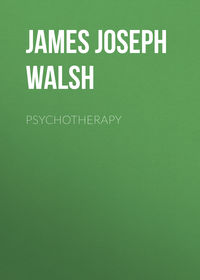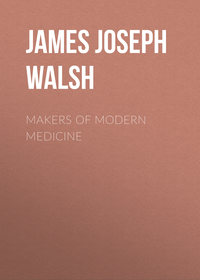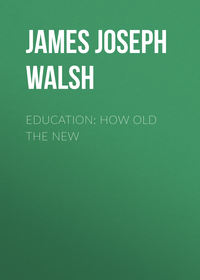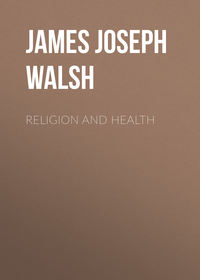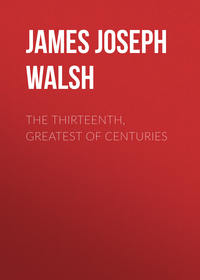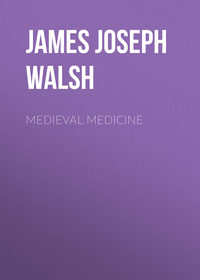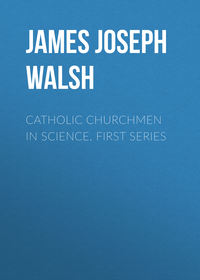 полная версия
полная версияThe Popes and Science

James J. Walsh
The Popes and Science / The History of the Papal Relations to Science During the Middle Ages and Down to Our Own Time
PREFACE
A new edition of this volume being called for, I take the occasion to place it under the aegis of the University of Notre Dame as a slight token of gratitude for the formal recognition of the work by the faculty of that institution, and bind this Notre Dame edition in the University colors, blue and gold.
There is much more readiness at the present time to accept the conclusions with regard to the relations of the Popes and science here suggested than there was when the book was first published. Knowledge of the general history of science has grown very materially in the last ten years. Every increase in historical knowledge has shown more and more clearly how utterly without foundation were many ideas which had been very commonly accepted, particularly in English-speaking countries, on the subjects here discussed. The supposed opposition to the development of science on the part of the Popes and the Church is now readily seen to have had no existence in reality, and popular notions on the subject were due entirely to ignorance of the history of science. There was supposed to be no scientific development and no nature study until quite recent times. The generations immediately preceding ours knew of none, and therefore concluded there must have been none. They went even farther, and felt that since there had been none, there must be some special reason for this lacuna in human progress. The Church and the Popes were the favorite scapegoats for human failings, so they were blamed. Now we know that there was a magnificent development of science, not only in the Renaissance period under the fostering care of the Popes and ecclesiastics, but also during the old university times. What has come above all to be recognized is that the medieval universities were scientific universities. They paid more attention to the ethical and philosophical sciences than we do, but they devoted a great deal of time to mathematics and the physical sciences. Mr. Huxley, in his inaugural address as Rector of the University of Aberdeen, declared thirty years ago that the curriculum of these old universities was better calculated to develop the many-sided mind of man than the curriculum of any modern university. Above all, in surgery and in medicine they did magnificent work. Anaesthesia, antisepsis, and the natural methods of cure were all anticipated in the medieval time. At the International Congress of Medicine last summer, a section on the history of medicine was organized because it has come to be recognized that very much that is even of practical value can be learned from medical history.
The fact of the matter is that during the eighteenth and early nineteenth centuries there was a great decadence of interest in scholarship and true education. There is a distinct descent in human culture at this time. Education was at its lowest ebb, hospitals {iv} were the worst ever built, art and architecture were neglected, and human liberty was so shackled that the French Revolution was needed to lift the fetters from men's minds as well as bodies. They, in their ignorance, spoke slightingly of old-time scholars. During the past century we have come to a better knowledge of the Middle Ages, and he is indeed a backward student of history who now thinks of them as "dark." Our millionaires have gathered, at immense expense, magnificent examples of the arts and crafts and beautiful books of the medieval and Renaissance periods. Our binders imitate their books, our artists study their works, we have revived their architecture and literature, are imitating their social ideas until, instead of "the dark ages," we have come to think of them as "the bright ages." What is not generally realized is that they are just as bright in science as they were in art, architecture, literature, and the arts and crafts.
Literally, the Popes were as much the patrons of science as they were of the arts. Professor White's book, "The Warfare of Science with Theology," like Professor Draper's "History of the Conflict Between Religion and Science," are now seen to represent simply an interesting evidence of the lack of real knowledge of the history of science and, above all, complete ignorance of details as to the genuine accomplishment of the olden time on the part of the generation by which they were taken seriously. Being quite sure that there was no science to speak of in the older times, these writers gathered every possible reference, found anywhere in secondary authorities, for they almost never went to the original documents, as evidence for their preconceived conviction that the Church must have suppressed science whenever that was possible. The real history of science was ignored. As soon as that is known there is no further question of Church opposition, but, on the contrary, of the extent of ecclesiastical patronage and encouragement of science.
Some of this very different story is told only too incompletely in this volume. It would take many volumes to give all the details of it. Readers will find here at least such references to the actual documentary history as will form a good basis for definite knowledge of the genuine relations of the Popes to science. The series of new appendices in this edition, especially those on Papal Physicians, Science in America, and the original Papal documents so often quoted, but seldom seen entire, is meant to supply material for the correction of many false notions that are unfortunately prevalent. They present historical matter that has not been readily available hitherto in English-speaking countries and that has nowhere been easy of access in the form here given.
Appendix VII by Rev. Father Leahy on The Fathers of The Church and Science presents a controverted point of history to persuasion. Appendix IX shows how amusing and amazing was Professor Draper's lack of knowledge of the history of science and above all of medicine and surgery when he wrote his "histories" that were so widely read and accepted because we in America knew no better for the moment.
PREFACE
For years, as a student and physician, I listened to remarks from teachers and professional friends as to the opposition of the Popes to science, until finally, much against my will, I came to believe that there had been many Papal documents issued, which intentionally or otherwise hampered the progress of science. Interest in the history of medicine led me to investigate the subject for myself. To my surprise, I found that the supposed Papal opposition to science was practically all founded on an exaggeration of the significance of the Galileo incident. As a matter of history, the Popes were as liberal patrons of science as of art. In the Renaissance period, when their patronage of Raphael and Michel Angelo and other great artists did so much for art, similar relations to Columbus, Eustachius, and Caesalpinus, and later to Steno and Malpighi, our greatest medical discoverers, had like results for science. The Papal Medical School was for centuries the greatest medical school in Europe, and its professors were the most distinguished medical scientists of the time. This is a perfectly simple bit of history that anyone may find for himself in any reliable history of medicine. The medical schools were the scientific departments of the universities practically down to the nineteenth century. In them were studied botany, zoology and the biological sciences generally, chemistry, physics, mineralogy and even astronomy, because of the belief that the stars influenced human constitutions. The Popes in fostering medical schools (there were four of them in the Papal dominions, and two of them, Bologna and Rome, were the greatest medical schools for several centuries) were acting as wise and beneficent patrons of science. Many of the greatest scientists of the Middle Ages were clergymen. Some of the greatest of them were canonized as saints. Albertus Magnus and Thomas Aquinas are typical examples. At least one Pope had been a distinguished scientist before being elected to the Papacy. For seven centuries the Popes selected as their physicians the greatest medical scientists of the {vi} time, and the list of Papal physicians is the worthiest series of names connected by any bond in the history of medicine, far surpassing in scientific import even the roll of the faculty of any medical school.
In a word, I failed to find any trace of Papal opposition to true science in any form. On the contrary, I found abundant evidence of their having been just as liberal and judicious patrons of science as they were of art and education in all forms. I found also that those who write most emphatically about Papal opposition to science, know nothing at all of the history of science, and above all of medicine and of surgery, during three very precious centuries. Because they know nothing about it they think there was none, and go out of their way to find a reason for its absence, while all the time there is a wondrous series of chapters of science for those who care to look for them. This is the story that I have tried to tell in this book.
This material is, I think, gathered into compact form for the first time. No one knows better than I do how many defects are probably in the volume. What I have tried to do is to present a large subject in a popular way, and at the same time with such references to readily available authorities as would make the collection of further information comparatively easy. I am sorry that the book has had to take on a controversial tone. No one feels more than I do that controversy seldom advances truth. There are certain false notions, however, which have the prestige of prominent names behind them, which simply must be flatly contradicted. I did not seek the controversy, for when I began to publish the original documents in the subject I mentioned no names. Controversy was forced on me, but not until I had made it a point to meet and spend many pleasant hours with the writer whose statements I must impugn, because they so flagrantly contradict the simple facts of medical history.
INTRODUCTION
When, some years ago, the announcement of the prospective opening of the medical school at Fordham University, New York City, was made, the preliminary faculty were rather astonished to find that a number of intelligent physicians expressed surprise that there should be any question of the establishment of a medical school in connection with a Catholic institution of learning, since, as they understood, the Church forbade the practice of dissection, and in general was distinctly unfavorable to the development of medical science. Most of us had already known of the false persuasion existing in some minds, that by a Papal decree the practice of dissection had been forbidden during the Middle Ages, but it was hard to understand how men should think, in this day of general information, that Catholics were not free to pursue the study of any true science, and above all medical science, without let or hindrance from ecclesiastical authorities. In a word, though we live in what we are pleased to call an enlightened age with the schoolmaster abroad in the land, as is so proudly proclaimed, we encountered the most childish simplicity of belief in a number of old-time prejudices as to the position of the Church with regard to the study of science.
We found such a curious state of positive ignorance and such an erroneous, pretentious knowledge with regard to the supposed attitude of the Church to medicine especially, that we realized that the first thing that the new medical department would have to do would be to set about correcting authoritatively the false notions which existed with regard to the Popes and medical science. Most of the misinformation in this matter in American minds, we soon found, had its origin in Dr. Andrew D. White's volumes, "On the History of the Warfare of Science with Theology in Christendom." It is impossible for anyone to read Dr. White's chapter on from Miracles to Medicine in this work without coming to the conclusion that the constant policy of the Church for all the centuries down practically to our own time was to prevent the progress of medicine as far as possible. The reason for this policy, presumably, must be taken to be that it was to the interest of the ecclesiastics to have people apply to them for healing. Sufferers were to look to miracles rather than to drugs for their relief from ailments of any and every kind. Prayers were to be considered as much more efficacious than powders, and Masses much more likely to do good than the most careful nursing. These ecclesiastical offices had to be paid for. Accordingly, people had to be discouraged from applying to physicians, medical schools were kept under an ecclesiastical ban, "dissection was prohibited," anatomy declared "a sin against the Holy Ghost," "chemistry forbidden under the severest penalties," "the medieval miracles of healing checked medical science," "the practice of surgery was relegated mainly to the lowest orders of practitioners and confined strictly to them," "as the grasp of theology upon education tightened, medicine declined," and every possible means was employed to keep the popular mind in subjection to the clergy, and to prevent physicians from getting so much knowledge as would enable them to help free the people from the bondage of superstition, of which they were the victims and the slaves.
We do not think that we exaggerate the impression likely to be obtained from Dr. White's book in stating the ordinarily accepted opinions thus baldly, and as a matter of fact, as the quotation marks are intended to show, most of the strongest phrases that we have used are Dr. White's own. For those who can take such statements in good faith, it must be a very genuine surprise to learn a few facts from the history of medicine in the Middle Ages. Before the beginning of the sixteenth century, that is, before the religious revolt in Germany, which has been dignified by the name of reformation, altogether some twenty medical schools were founded in various parts of Europe. Of these, the best known in the order of their foundation were Salerno, Bologna, Naples, Montpelier, Paris, Padua and Pisa. Excellent schools, however, were established also at Oxford, Rome, Salamanca, Orleans and Coimbra. Even early in the fourteenth century such unimportant towns as Perugia, Cahors and Lerida had medical schools. These schools were usually established in connection with the universities. It was realized that this would make the teaching of medicine more serious and keep the practical side of medicine from obscuring too much the scientific and cultural aspects of the medical training. In modern times in America we made the mistake of having our medical schools independent of universities, but with the advance in education and culture we have come to imitate the custom of the thirteenth and the fourteenth century in this regard.
The universities, as is well known, were the outgrowth of cathedral schools. Practically all those in authority in them, by far the greater number of teachers and most of the pupils, were of the clerical order, that is, had assumed some ecclesiastical obligations and were considered to be churchmen. At these universities, if we can trust the example of England as applicable to the Continent also, there were, according to trustworthy, conservative statistics, more students in attendance in proportion to the population than there has been at any period since, or than there are even at the present time in the twentieth century in any country of the civilized world. From this we can readily appreciate the enthusiastic ardor of those seeking education. Of these large numbers, the medical schools had their due proportion. [Footnote 1]
[Footnote 1: This subject of the attendance at the universities of the Middle Ages is discussed, and authorities quoted, in my book "The Thirteenth, Greatest of Centuries," published by the Catholic Summer School Press, N. Y.]
Of course it will be said at once that though there were medical schools and medical professors and students, what was taught and studied at this time was so far distant from anything like practical knowledge of medicine, that it does not tell against the argument that medical education was practically non-existent. Some people will perhaps harbor the thought, if they do not frankly express it, that very probably these schools were organized under ecclesiastical authority, only in order to enable the Church and the clergy to maintain their control of medical education and keep the people from knowledge that might prove dangerous to Church authority. They were thus able to satisfy some of men's cravings for information in these matters, and yet prevent them from making such advances as would endanger the Church's policy of having them apply for prayers and Masses rather than for more physical remedies, except possibly for certain minor ailments. We do not doubt that there are many educated people who would be quite satisfied to accept this as a complete explanation of the situation in medical education at the medieval universities. Those who have read Dr. White's "History of the Warfare of Theology with Science" and have placed any faith in his really amusing excursions into a realm of which apparently he knows nothing– the history of medicine–must believe something like this. For them a little glance at even a few of the realities of medical teaching in the thirteenth century will show at once what a castle of the imagination they have been living in.
Only those who are thoroughly and completely ignorant of the real status of medical teaching in the thirteenth and fourteenth centuries continue to hold these absurd opinions as to the nullity of medieval medicine and surgery. The reading of a single short recent contribution to medical history, the address of Professor Clifford Allbutt, Regius Professor of Physic at the University of Cambridge, England, before the Congress of Arts and Sciences at the Exposition held in St. Louis in 1904, "On the Historical Relations of Medicine and Surgery down to the Sixteenth Century," would suffice to eradicate completely such traditional errors. He pointed out some surprising anticipations of what is most modern in medicine and surgery in the teachings of William of Salicet and his pupil Lanfranc, Professors of Medicine and Surgery in the Italian Universities and in Paris during the thirteenth century. As these two professors were the most distinguished teachers of surgery of the period and the acknowledged leaders of thought in their time, their teaching may fairly be taken as representative of the curricula of medieval medical schools. William of Salicet, according to Professor Allbutt, taught that dropsy was due to a hardening of the kidneys; durities renum are his exact words. He insisted on the danger of wounds of the neck. He taught the suture of divided nerves and gave explicit directions how to find the severed ends. He made a special study of suppurative disease of the hip and taught many practical things with regard to it. He taught, though this is a bit of knowledge supposed to come three centuries later into medicine and history, the true origin of chancre and phagedena. Most surprising of all, however, remains. William substituted the use of the knife for the abuse of the cautery, which had been introduced by the Arabs because they feared hemorrhage, and he insisted that hemorrhage could be controlled by proper means without searing the tissues, and that the wounds made by the knife healed ever so much more kindly and with less danger to the patient. In the matter of wound healing, he investigated the causes of the failure of healing by first intention, and expressed on this subject some marvelous ideas that are supposed to be of late nineteenth century origin.
While it is usually said that whatever teaching of science was done at medieval universities, was so entirely speculative or purely theoretic and so thoroughly impractical as not to be of any serious use for life and its problems, the utter falsity of such declarations can be seen from the fact that William of Salicet insisted on teaching medicine by clinical methods, always discussed cases with his students, and his medical and surgical works contain many case histories. This is just what pretentiously ignorant historians of medical education have often emphatically declared that medieval teachers did not do, but should have done, in the Middle Ages. It is not surprising then to find that William himself, and his great pupil Lanfranc, insisted on the utter inadvisability of separating medicine and surgery in such a way that the physician would not have the opportunity to be present at operations, and thus gain more definite knowledge about the actual conditions of various organs which he had tried to investigate from the surface of the body. It is a very curious coincidence that both the Regius Professors of Physic in England at the present time, our own Professor Osler, now at Oxford, as well as his colleague, Professor Allbutt, of Cambridge, have within the last five years emphasized this same idea in almost the very words which were used by William and Lanfranc nearly seven hundred years ago. Lanfranc went even beyond his master in practical applications of important scientific principles to medicine and surgery. He added to the means of controlling hemorrhage. In arterial hemorrhage he suggested digital compression for an hour, or in severe cases ligature. His master had studied wounds of the neck. Lanfranc has a magnificent chapter on injuries of the head, which Professor Allbutt does not hesitate to call one of the classics of surgery. Lanfranc was thoroughly appreciated by his contemporaries. After years of study and teaching in Italy he was invited to Paris, where he became one of the lights of that great university. Both Salicet and Lanfranc did their wonderful work in scientific medicine down in Italy where ecclesiastical influence was strongest. Italy continued to be for the next six centuries always the home of the best medical schools in the world, to which the most ardent students from all over the continent and even England went for the sake of the magnificent opportunities provided. It was literally true, in spite of the tradition of Church opposition to medical science, that the nearer to Rome the university the better its medical school; and as we shall see, Rome itself had the best medical school in the world for two centuries, while its greatest rival, often ahead of it in scientific achievement, always its peer, was the medical school of Bologna in the Papal States, directly under the control of the Popes since the beginning of the sixteenth century.
Dr. White has said just the opposite of this in a well-known passage of his book, in which he assures his readers that "in proportion as the grasp of theology upon education tightened, medicine declined; and in proportion as that grasp relaxed, medicine has been developed." The reason for such a statement is that he knew nothing about the history of medicine and surgery in these medieval centuries and thought there was none. This is a characteristic example of his mode of writing the History of the (Supposed) Warfare of Theology with Science in Christendom. This much will give some idea of the value of his book as a work of reference.
After knowing something of these wonderful developments of medieval medical science, it is to be hoped that no one will listen hereafter to the ignorant assertions of those who talk of the suppression of medical knowledge at this time. William of Salicet and Lanfranc were both of them clerics, that is, they belonged to the ecclesiastical body and had taken minor orders, though they were not priests, as priests were for obvious reasons not allowed to do surgical operations, it being as repugnant to human feelings in the Middle Ages as it is now, that the messenger of Divine Mercy should handle the knife and spill blood, or that the pastor of souls should come straight from the operating room to bring consolation to the afflicted and the dying.
Much more might be said about the wonderful medical teaching of the thirteenth century. The men who made the universities what they have continued to be down to the present time, had open minds for any great advances that might come. Accordingly, when the histories of anesthesia tell us that there was a form of anesthesia introduced during the thirteenth century by Ugo da Lucca, and that even some method of inhalation was employed for this purpose, it will be a surprise only to those who have never properly realized all that our educational forefathers of the early university days succeeded in accomplishing.


